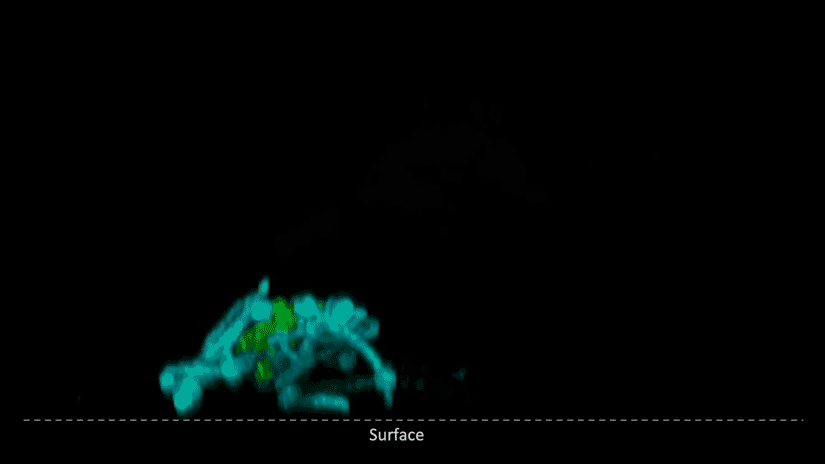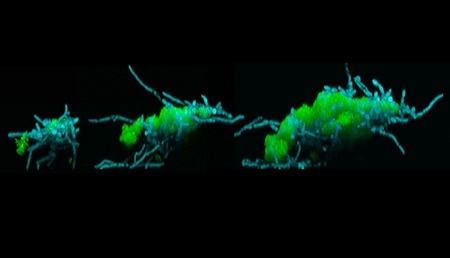Research Quick Pics
By Tiffany Chen
October 31, 2022
This creeping creature did not walk out of a sci-fi film—it actually plays a starring role in the mouth. It’s composed of cavity-causing bacteria (green) that piggyback on fungi (blue), forming superorganisms with unusual powers—“walking” and “lunging” on tooth-like surfaces. These movements allow the microbial assemblages, which thrive on sugar, to spread faster and farther than either organism alone, making them extra skilled at promoting tooth decay. The results of the NIDCR-supported study were published October 3 in the Proceedings of the National Academy of Sciences.
“This is not something I would even dream about,” said co-senior author Hyun (Michel) Koo, D.D.S., Ph.D., a professor of orthodontics at the University of Pennsylvania, who co-led the research with Knut Drescher, Ph.D., an associate professor at the University of Basel in Switzerland. “These organisms from different kingdoms are nonmotile, meaning they can’t move by themselves. But when together, they develop mobility that’s usually reserved for higher organisms such as insects and vertebrates.”
The researchers discovered the cross-kingdom assemblages in the saliva of young children with severe tooth decay. In lab experiments, real-time imaging revealed that the microbial clusters move across tooth-like surfaces by using the fungi’s fiber-like hyphae as “legs.”
As the hyphae elongate, they push against the surface, thrusting the cluster up and forward in a manner that resembles walking and lunging. While the fungi are doing all the legwork, the bacteria hitching a ride are busy growing and expanding. This concerted action allowed the assemblages to rapidly form biofilms (dental plaque), sticky networks of microbes that can lead to tooth decay and gum disease.
The bacterial-fungal clusters were also more resistant to antimicrobial agents commonly used in mouthwash and tougher to rinse off tooth-like surfaces than either species alone. On pieces of real human teeth, the assemblages formed denser biofilms and caused more extensive enamel damage and decay.
The results could provide insights into preventions and treatments for tooth decay, which affects 42% of American children and 59% of adolescents ages 12 to 19.
Related Links
- A Microbial World on the Top of Your Tongue
- The Creatures Crawling Within
- How Fungus Finds a Foothold in the Mouth
Reference
Ren Z, Jeckel H, Simon-Soro A, Xiang Z, Liu Y, Cavalcanti IM, Xiao J, Tin NN, Hara A, Drescher K, Koo H. Interkingdom assemblages in human saliva display group-level surface mobility and disease-promoting emergent functions. Proc Natl Acad Sci U S A. 2022 Oct 11;119(41):e2209699119. doi: 10.1073/pnas.2209699119. Epub 2022 Oct 3. PMID: 36191236; PMCID: PMC9565521.
Attention Editors
Reprint this article in your own publication or post to your website. NIDCR News articles are not copyrighted. Please acknowledge NIH's National Institute of Dental and Craniofacial Research as the source.
Subscribe to NIDCR Science News
Receive monthly email updates about NIDCR-supported research advances by subscribing to NIDCR Science News.



